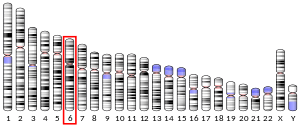ORC3
| Origin recognition complex (ORC) subunit 3 N-terminus | |||||||||
|---|---|---|---|---|---|---|---|---|---|
| Identifiers | |||||||||
| Symbol | ORC3_N | ||||||||
| Pfam | PF07034 | ||||||||
| InterPro | IPR010748 | ||||||||
| |||||||||
Origin recognition complex subunit 3 is a protein that in humans is encoded by the ORC3 (ORC3L) gene.[5][6][7]
Function
The origin recognition complex (ORC) is a highly conserved six subunits protein complex essential for the initiation of the DNA replication in eukaryotic cells. Studies in yeast demonstrated that ORC binds specifically to origins of replication and serves as a platform for the assembly of additional initiation factors such as Cdc6 and Mcm proteins. The protein encoded by this gene is a subunit of the ORC complex. Studies of a similar gene in Drosophila suggested a possible role of this protein in neuronal proliferation and olfactory memory. Alternatively spliced transcript variants encoding distinct isoforms have been reported for this gene.[7]
Interactions
ORC3 has been shown to interact with:
References
- 1 2 3 GRCh38: Ensembl release 89: ENSG00000135336 - Ensembl, May 2017
- 1 2 3 GRCm38: Ensembl release 89: ENSMUSG00000040044 - Ensembl, May 2017
- ↑ "Human PubMed Reference:".
- ↑ "Mouse PubMed Reference:".
- ↑ Tugal T, Zou-Yang XH, Gavin K, Pappin D, Canas B, Kobayashi R, Hunt T, Stillman B (Dec 1998). "The Orc4p and Orc5p subunits of the Xenopus and human origin recognition complex are related to Orc1p and Cdc6p". The Journal of Biological Chemistry. 273 (49): 32421–9. PMID 9829972. doi:10.1074/jbc.273.49.32421.
- 1 2 3 4 Pinto S, Quintana DG, Smith P, Mihalek RM, Hou ZH, Boynton S, Jones CJ, Hendricks M, Velinzon K, Wohlschlegel JA, Austin RJ, Lane WS, Tully T, Dutta A (May 1999). "latheo encodes a subunit of the origin recognition complex and disrupts neuronal proliferation and adult olfactory memory when mutant". Neuron. 23 (1): 45–54. PMID 10402192. doi:10.1016/S0896-6273(00)80752-7.
- 1 2 "Entrez Gene: ORC3L origin recognition complex, subunit 3-like (yeast)".
- 1 2 3 4 5 Kneissl M, Pütter V, Szalay AA, Grummt F (Mar 2003). "Interaction and assembly of murine pre-replicative complex proteins in yeast and mouse cells". Journal of Molecular Biology. 327 (1): 111–28. PMID 12614612. doi:10.1016/s0022-2836(03)00079-2.
- 1 2 3 Dhar SK, Delmolino L, Dutta A (Aug 2001). "Architecture of the human origin recognition complex". The Journal of Biological Chemistry. 276 (31): 29067–71. PMID 11395502. doi:10.1074/jbc.M103078200.
- ↑ Matsuoka S, Ballif BA, Smogorzewska A, McDonald ER, Hurov KE, Luo J, Bakalarski CE, Zhao Z, Solimini N, Lerenthal Y, Shiloh Y, Gygi SP, Elledge SJ (May 2007). "ATM and ATR substrate analysis reveals extensive protein networks responsive to DNA damage". Science. 316 (5828): 1160–6. PMID 17525332. doi:10.1126/science.1140321.
- 1 2 3 4 Vashee S, Simancek P, Challberg MD, Kelly TJ (Jul 2001). "Assembly of the human origin recognition complex". The Journal of Biological Chemistry. 276 (28): 26666–73. PMID 11323433. doi:10.1074/jbc.M102493200.
Further reading
- Maruyama K, Sugano S (Jan 1994). "Oligo-capping: a simple method to replace the cap structure of eukaryotic mRNAs with oligoribonucleotides". Gene. 138 (1-2): 171–4. PMID 8125298. doi:10.1016/0378-1119(94)90802-8.
- Suzuki Y, Yoshitomo-Nakagawa K, Maruyama K, Suyama A, Sugano S (Oct 1997). "Construction and characterization of a full length-enriched and a 5'-end-enriched cDNA library". Gene. 200 (1-2): 149–56. PMID 9373149. doi:10.1016/S0378-1119(97)00411-3.
- Springer J, Nanda I, Hoehn K, Schmid M, Grummt F (2000). "Identification and chromosomal localization of murine ORC3, a new member of the mouse origin recognition complex". Cytogenetics and Cell Genetics. 87 (3-4): 245–51. PMID 10702681. doi:10.1159/000015435.
- Thome KC, Dhar SK, Quintana DG, Delmolino L, Shahsafaei A, Dutta A (Nov 2000). "Subsets of human origin recognition complex (ORC) subunits are expressed in non-proliferating cells and associate with non-ORC proteins". The Journal of Biological Chemistry. 275 (45): 35233–41. PMID 10954718. doi:10.1074/jbc.M005765200.
- Wiemann S, Weil B, Wellenreuther R, Gassenhuber J, Glassl S, Ansorge W, Böcher M, Blöcker H, Bauersachs S, Blum H, Lauber J, Düsterhöft A, Beyer A, Köhrer K, Strack N, Mewes HW, Ottenwälder B, Obermaier B, Tampe J, Heubner D, Wambutt R, Korn B, Klein M, Poustka A (Mar 2001). "Toward a catalog of human genes and proteins: sequencing and analysis of 500 novel complete protein coding human cDNAs". Genome Research. 11 (3): 422–35. PMC 311072
 . PMID 11230166. doi:10.1101/gr.GR1547R.
. PMID 11230166. doi:10.1101/gr.GR1547R. - Vashee S, Simancek P, Challberg MD, Kelly TJ (Jul 2001). "Assembly of the human origin recognition complex". The Journal of Biological Chemistry. 276 (28): 26666–73. PMID 11323433. doi:10.1074/jbc.M102493200.
- Dhar SK, Delmolino L, Dutta A (Aug 2001). "Architecture of the human origin recognition complex". The Journal of Biological Chemistry. 276 (31): 29067–71. PMID 11395502. doi:10.1074/jbc.M103078200.
- Kneissl M, Pütter V, Szalay AA, Grummt F (Mar 2003). "Interaction and assembly of murine pre-replicative complex proteins in yeast and mouse cells". Journal of Molecular Biology. 327 (1): 111–28. PMID 12614612. doi:10.1016/S0022-2836(03)00079-2.
- Ramachandran N, Hainsworth E, Bhullar B, Eisenstein S, Rosen B, Lau AY, Walter JC, LaBaer J (Jul 2004). "Self-assembling protein microarrays". Science. 305 (5680): 86–90. PMID 15232106. doi:10.1126/science.1097639.
- Sibani S, Price GB, Zannis-Hadjopoulos M (May 2005). "Ku80 binds to human replication origins prior to the assembly of the ORC complex". Biochemistry. 44 (21): 7885–96. PMID 15910003. doi:10.1021/bi047327n.
- Matsuoka S, Ballif BA, Smogorzewska A, McDonald ER, Hurov KE, Luo J, Bakalarski CE, Zhao Z, Solimini N, Lerenthal Y, Shiloh Y, Gygi SP, Elledge SJ (May 2007). "ATM and ATR substrate analysis reveals extensive protein networks responsive to DNA damage". Science. 316 (5828): 1160–6. PMID 17525332. doi:10.1126/science.1140321.




